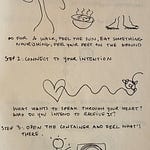This is the second of a two-part series. Part 1 addresses software as a channel for your intentions, focusing on communications software and social media. Part 2 focuses on productivity software in an individual and small business context.
“Imagine four pots,” I said to Sandra as we sat at her kitchen table. “One is Basecamp, one is Circle [the community platform on which we’re building our startup], one is iMessage, one is Google Drive. Which ingredients go in which pot?” All four platforms have chat functionality, storage, and other similar features. “The way we use them should align with our intentions.” My proposal was to use Basecamp for anything associated with an action, Circle to test how the flow of the community would work, iMessage for friend stuff and anything urgent, and Google Drive for documentation. “And we’ll give each other grace when we put things in the wrong place,” Sandra added. Agreed.
When building from the heart, it can easily feel overwhelming to interface with technology, especially if your experience isn’t building software (and even if it is). But it’s like getting to know your kitchen equipment. Using my pots and pans and vessels at home, I know that one cast-iron pan conducts heat faster than another. One ceramic bowl holds soup beautifully, while another wants berries or snacks. One tall narrow vase is great for branch cuttings from the yard. Mason jars and deli containers and glass tupperware all hold food, but their different shapes and sizes and materials lend themselves to different leftovers. You get the idea.
I approach software the same way. I use it, and I get to know its vibration. What is it intended for, and what is my intention? What’s possible when I weave these intentions together – and they join the intentions of others? The combined intentions of people and software (which is formed by the intentions of the people who made the software, and the hardware it runs on) become vessels for co-creation, building something new to the world.
It feels powerful and empowering when you find or create the right container for your intentions. My friend Teresa told me how she recently created a Microsoft OneNote repository for ideas related to the book she’s writing, and having a place for those ideas has made the book more real. I love this example, how she’s bringing an idea into form through this tool and her own creativity. (She’s also an excellent cook.)
To practice this for your own intentional technology use, you can adapt the steps outlined in Part 1 of this series, with the modification of feeling how software can hold your intention, in addition to letting it flow through as a channel (think of a pond holding water as a container, and a stream flowing into and out of it as a channel). What’s possible when you’re able to hold your intention in this way? What deepens? What develops? How does it intersect with others’ intentions, both the people you collaborate with and the people who created the container you’re using?













